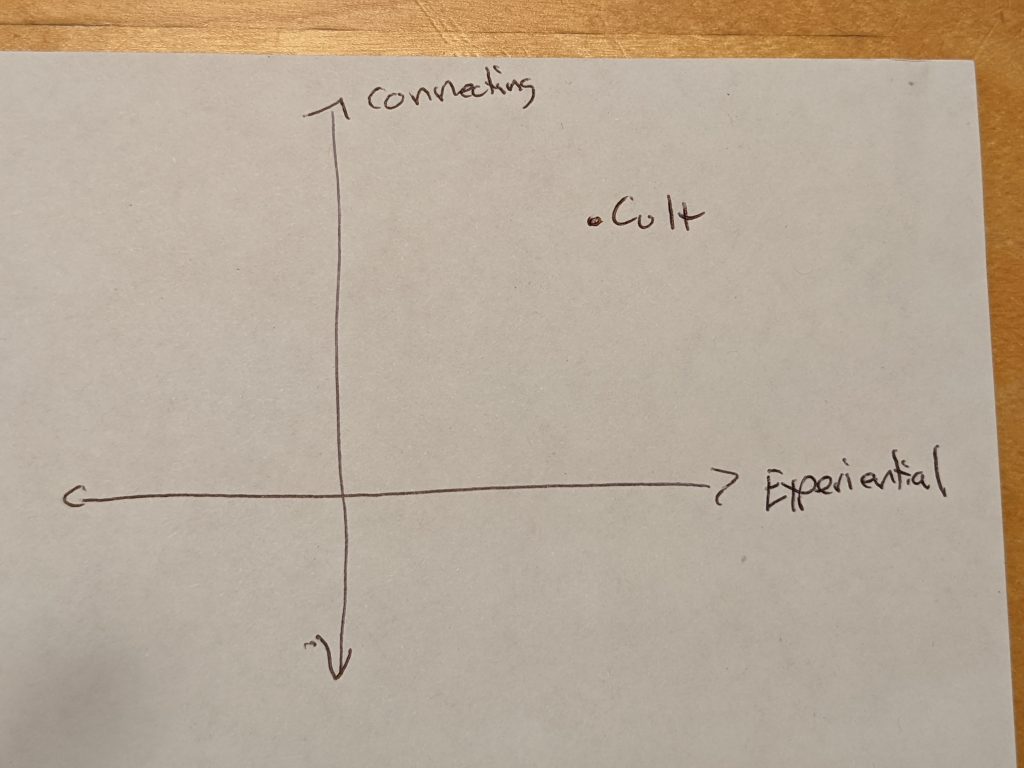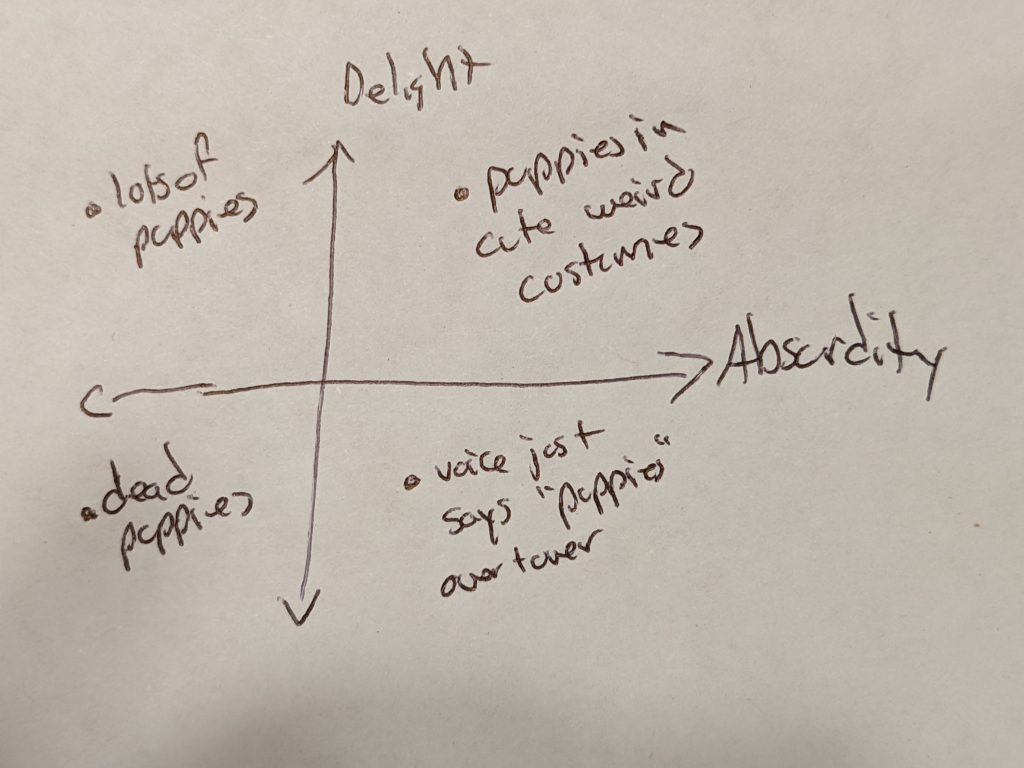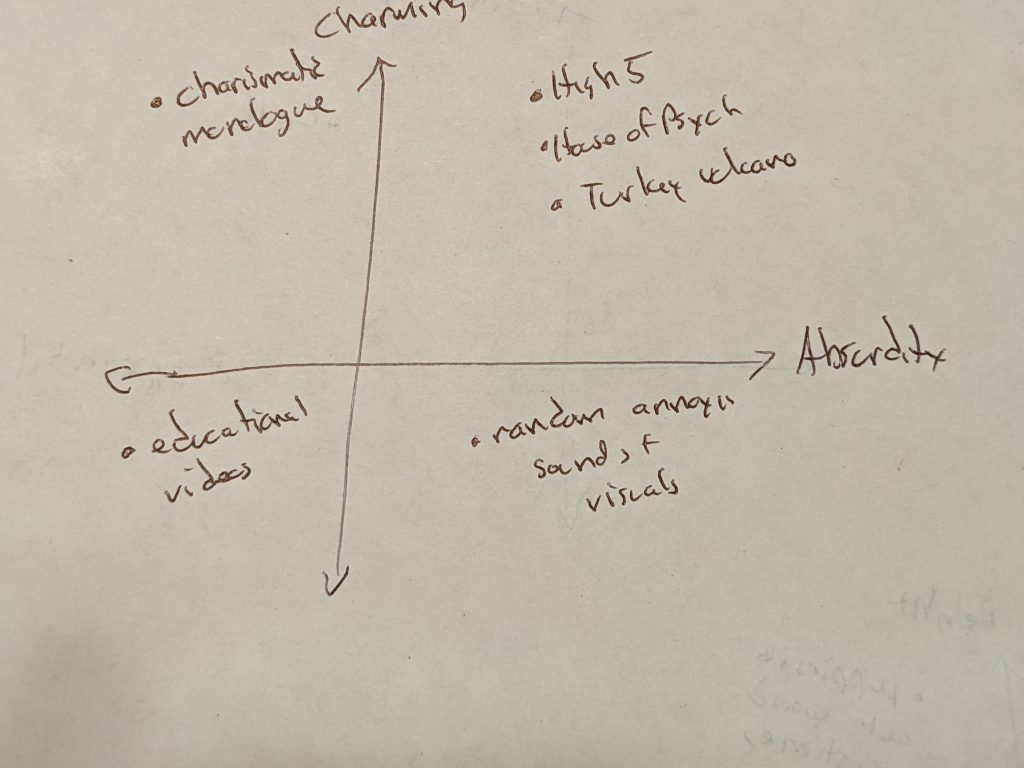This post is part of a four-part set that details just one possible (and evolving) method to develop a useful mission statement. Read part one here.
The Graph Technique
In the last post, you came up with lists of potential words. Now we’re going to take the tools, purpose, and beneficiary lists and narrow each down to the two words that, when combined, describe that dimension the best.
At the end we’ll end up with three sets of two words. Then we’ll use those words to build the final mission statement. Typically it is in this form: We help (beneficiary) do (purpose) by (tools).
Everything It Is and Nothing It Isn’t
Our goal here is to eventually discover the two words that fully encompass that dimension (tools, purpose, or beneficiary) and fully exclude everything that is not in that dimension.
What makes missions useful isn’t that they are inspiring or communicate your project or organization externally. What makes them useful is that you use them internally to help you make important decisions. When new opportunities or challenges come up, you can use the mission to determine if a proposed course of action is appropriate.
If your mission has been narrowed to everything you do but nothing more than you do then can avoid a lot of confusion and disagreements and move faster knowing that you are on the right track.
(Note: the methodology I use here was inspired/borrowed/stolen from Seth Godin’s “positioning as a service” axes concept. I don’t think it’s the use case he designed it for, but I think it helps.)
The Possibilities Graph
What we’ll do is pick one of the lists to start with. I’m going to choose “tools” for this example because it’s easier to visualize. But I would recommend starting with the beneficiary list, moving to the purpose list and then lastly doing the tools list. Otherwise you can end up with a hammer-looking-for-nails situation.
We’ll take two words from the list and place one on each axis.
Then we’ll think about the kinds of businesses that might lie in each resultant quadrant. The more “negative” you go on each axis indicates that the less it has of that quality and the further you go toward the “positive” side indicates the more it has of that quality
As we brainstorm possibilities that might exist in each quadrant, we start seeing two things about these possibilities:
- There are some possibilities that have both qualities that don’t feel like mission.
- There are some possibilities you feel are core to mission but don’t have both qualities.
If you discover either of these cases, you’ll start swapping words out that are more and more appropriate and fit better, and then redraw the axes and come up with new possibilities.
Eventually you’ll get to where the upper right quadrant (heretofore referred to as “Quadrant 2) has everything you want and nothing you don’t want.
You might be wondering, “Why two words? Couldn’t we do three?” There’s nothing really magical or scientific about two words, but I’ve seen from experience two is sufficient and adding a third axis adds unnecessary difficulty.
The Possibilities Graph in Action
Since it’s easier to understand the graph technique with an example, I’m going to walk you through a much abbreviated version of how I determined the Eureka Room’s mission.
Let’s assume I had a list of potential Tool Words already.
Edgy + Experimental
First, I’ll pull “Edgy” and “Experimental” from my list and put them on a new graph.
What these words mean to me might be different than what they mean to you. For example, “experimental” means something people have seen done before. “Edgy” means perhaps jarring or having an emotional bite to it. Be sure you know what the words mean to you (or to everyone, if you are doing this exercise in a group), because otherwise the exercise will not get you where you need to be. For groups you might have to explicitly write out shared definitions of words to ensure that you share the same meaning.
Knowing that the physical form of my project is a room that has a movie screen and some lights on the walls, here’s what the new words generate for what it “isn’t”:
- Low Edgy + Low Experimental = “show mainstream movies”
- Low Edgy + High Experimental = “a meditation room with lights”
- High Edgy + Low Experimental = “show indie movies”
(Note: to make the process clearer to comprehend I have included just one possibility per quadrant but in practice you should try to think of at least two or three).
When you find two words that are strong contenders, try to think of things that are as different from your project as possible but can be described by those two words. The goal is to see if we can think of a possibility that lies in Quadrant 2 that is NOT the Eureka Room. We come up with:
- High Edgy + High Experimental = “room of noise and glitchy lights”
Now I check my gut on what The Eureka Room means to me. How does “room of noise and glitchy lights” match up to what I feel it really is?
As soon as I do that check in, I know the High Edgy+ High Experimental idea is *not* the Eureka Room. I don’t want noise and glitchiness. These words do not define Quadrant 2 closely enough. The boundaries of these words allow for projects that are not the WHAT of the Eureka Room.
Here’s what the graph looks like.

Let’s choose a couple more.
Connecting + Experiential
Next I’ll choose “Connecting” and “Experiential”.
For this attempt I’ve chosen two new words, but you could also have kept one of the previous words and swapped out the other. In fact, after working this exercise for a while you’ll probably find a word you think is right, at which point you’ll start testing how it combines with other words on the list.
This time, instead of starting in the “NOT” quadrants, let’s start in Quadrant 2. (Just to show you it really doesn’t matter where you start). What is something that lies in Quadrant 2 that is NOT something I would consider “The Eureka Room”?
- High Connecting + High Experiential = Cult
Ok, I’m not starting a cult here. We don’t need to explore possibilities for the NOT quadrants. We know these words aren’t going to work. They don’t define Quadrant 2 narrowly enough. Let’s try some others.

Predictable + Connective
Let’s try two other words in the list: “Predictable” and “Connective”.
- High Predictable + Low Connective = Mainstream movie you passively watch.
- Low Predictable + High Connective = Visitors are told to high five each other in random ways.
- Low Predictable + Low Connective = Random images and sound on a screen as people sit passively
- High Predictable + High Connective = Team sports.

The Low Predictable + High Connective option here is an actual program I made for the Eureka Room. But with the words I chose, it is not where it needs to be (in Quadrant 2).
Additionally, one item in Quadrant 2 is “team sports” but that doesn’t resonate as the Eureka Room to me.
At this point I think, “Ok, so what is another way to say low predictable?” It could be unpredictable but I want to stay away from negation words. I could say “random”, but my gut tells me it’s not just random like digits of pi. It’s a weirdness. It’s absurdity.
Let’s try absurdity and pull another word from the list. I’m going to set aside “connective” for now. I sense that “connection” might be a “purpose” word instead of a “tool” word.
Delight + Absurdity
I choose “Delight” and “Absurdity”.
Then I think of some fictional projects for each quadrant. I try to think of ones I might actually like to do, but if they are all unappealing, that’s OK.
- High Delight + Low Absurdity = puppies running around excitedly
- Low Delight + Low Absurdity = dead puppies
- Low Delight + High Absurdity = a voice that just says the word “puppies” at random intervals for an hour.
Now let’s brainstorm the Quadrant 2. For this one I want to prove my hypothesis wrong. I want to see if there’s anything in Quadrant 2 that I could think of that I my instinct says “nope, that’s not the Eureka Room”.
Obviously I think the Eureka Room goes there else I wouldn’t have considered this pairing in the first place. However I don’t want to fall victim to confirmation bias so I really try hard to think of things that I would not want to do that also fall in Quadrant 2. Involve a friend that is good at brainstorming if you can. Here’s one possibility:
- High Delight + High Absurdity = puppies in cute weird costumes.

My gut says there’s something missing. What I want is something close to delight, but more magical. Something more personal. I dig through the thesaurus and come upon “Charming”.
Charming + Absurdity
I make a new graph with “charming” and “absurdity”.
Quadrant 2:
- The High 5 program lands in the Quadrant 2. So do some other programs I’ve made.
The NOT Quadrants
- High Charming + Low Absurdity = monologue by a charismatic person
- Low Charming + Low Absurdity = educational videos
- Low Charming + High Absurdity = random annoying sounds and visuals

I try to brainstorm something in Quadrants 1, 3, and 4 that my instinct says “That’s the Eureka Room” but I can’t come up with anything. Great.
I try to brainstorm something in Quadrant 2 that my instinct says “That’s not the Eureka Room”, but I can’t come up with anything. Great.
We have our two best words.
What’s Next
We’ve reached a point where we can feel pretty confident about our two choices for “Tools” words. Now we repeat the process for the Purpose List and the Beneficiary List.
Once we’re done with those lists we can assemble our Mission Statement.
But before we do that, I want to walk you through how a brainstorming session goes.
My examples here make it appear that the possibilities put onto the graph just instantaneously pop in my head and neatly go in each quadrant. In reality, generating these possibilities takes more work and more conversation (either with yourself or in a group). Ideally you can have someone help talk you through things. This will lessen things like confirmation bias and the many other biases we can fall victim to in a brainstorming session.
My next posts details out a semi-fictional example of what that conversation looks like. See post #3 here.